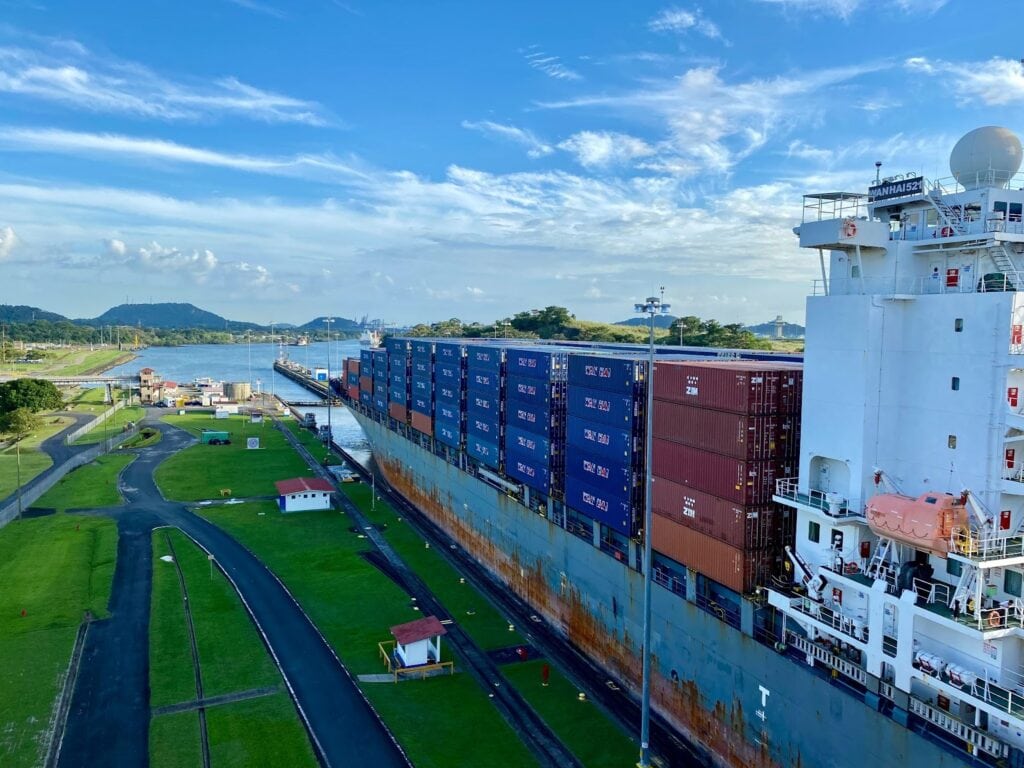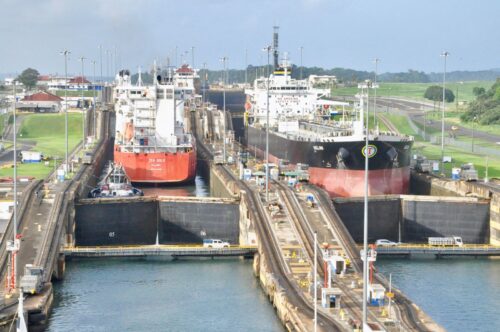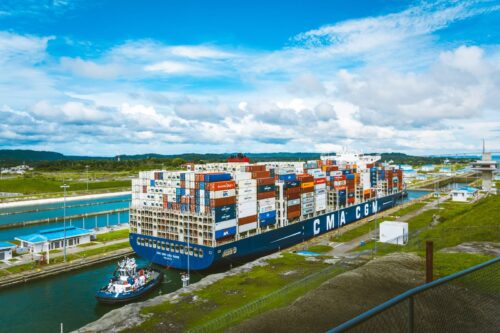Panamax Ship: History, Advantages, and Capacity

The Panamax ship revolutionized the shipping industry, setting new size standards for vessels traversing the Panama Canal. These unique ship designs were born out of necessity, catering to the canal’s dimension restrictions while maximizing cargo capacity.
The term “Panamax,” derived from maximum acceptable dimensions in Panama Canal locks, has spurred significant developments in container ship design. Innovations have exploited canal limitations to optimize vessel size, length, and freight load.
Today’s Panamax vessels include medium-sized ships – smaller than behemoth carriers but capable of moving substantial volumes efficiently and ecologically via popular Panama Canal trade routes.
Panamax is crucial in balancing economies of scale with seaborne trade demands.
Panamax Ships Origin and History of Development
Panamax vessels originated in the early 20th century as a result of the construction of the Panama Canal, which required vessels to meet specific size requirements to pass through its locks, according to the Panama Canal Authority.
Vessel Design
Panamax ships boast an intelligently crafted design optimized to traverse the Panama Canal. With these specifications, they proficiently capitalize on every inch of space available within this significant waterway.
Panamax vessels are designed with utmost precision and feature high structural integrity and load-bearing capabilities that facilitate smooth sea voyages by ensuring stability in various weather conditions while carrying massive cargo loads up to 120,000 DWT or 5,000 TEU containers.
Vessel Length, Width, and Crucial Specs
The Panamax ships are renowned for their distinct size, which is meticulously measured and calculated to optimize the Panama Canal’s beam width constraints. The maximum measurements of these vessels stand 106 feet in width and 965 feet in length.
This design restriction ensures they smoothly navigate the canal, making them a critical gear in global maritime commerce. Their draft also measures an interesting depth of about 39.4 feet in tropical freshwater.
Built with intricate precision based on stringent dimensions specifications, these medium-sized behemoths balance capacity with functionality remarkably well. They boast impressive cargo transportation abilities within the prescribed Panamax size limits.
Vessel Cargo Capacity
Panamax ships are renowned in the global shipping industry for their substantial cargo capacity. They were specifically designed to maximize the volume of goods they could transport compared to larger ships.
This strategic balance allows Panamax vessels to carry 65,000 to 80,000 DWT. Even more impressive is that new Panamax container ships have increased this load-carrying potential further, capable of handling up to 120,000 DWT and transporting approximately 5,000 twenty-foot equivalent units (TEUs).
The immense cargo capacity has undeniably propelled these vessels into a pivotal role in shaping global shipping markets and trade routes. Such significant contributions have optimized port infrastructure and necessitated upgrades to accommodate larger vessels effectively.
Vessel Cargo: Type of Products
Panamax ships are versatile vessels transporting various products across the world’s oceans. These cargo ships are commonly used for shipping containerized goods, such as manufactured goods, electronics, and consumer products.
Panamax ships also transport bulk commodities like coal, iron ore, grain, and oil. The flexibility of these vessels allows them to cater to various industries and meet the demands of global trade.
With their substantial capacity ranging from 65,000 to 80,000 DWT (deadweight tonnage), they play a crucial role in maintaining efficient maritime transportation and facilitating international commerce.
Vessel and Crew
Panamax ships are a type of vessel that has played a crucial role in global trade for many years. These vessels are specifically designed to navigate the locks and channels of the Panama Canal, allowing them to transport goods efficiently between the Atlantic and Pacific Oceans.
To operate these massive vessels, they require a crew consisting of highly skilled professionals who manage various aspects of ship operations, including navigation, engineering, and logistics. Typically, it takes between 20 to 35 crew members to operate the vessel. However, they are not passenger ships.
The development and design of Panamax ships have been influenced by historical evidence dating back to ancient Egypt when trading vessels became rounder in shape to accommodate as small as possible crews.
Vessel Speed
Panamax ships are known for their impressive speed, allowing them to transport cargo across the globe efficiently. These vessels can reach up to 25 knots (around 29 miles per hour).
With this high-speed capability, Panamax ships can quickly navigate international waters and meet tight delivery deadlines. This ensures that goods arrive on time and minimizes transportation costs.
Panamax ships are designed to cover large distances in record time while maintaining optimal performance and fuel efficiency, whether carrying containers, bulk cargo, or oil tankers.
How and Where Panamax Ships Are Made
Panamax ships are manufactured in shipyards worldwide. These shipyards have specialized facilities and advanced technologies to construct these large-scale vessels.
The process begins with detailed engineering and design work, considering the specific requirements of Panamax ships. Skilled technicians and workers then use high-quality materials, such as steel, to build the hull and other structural components of the ship.
Once complete, rigorous testing ensures that all systems and equipment meet safety standards before Panamax ships can sail on their designated routes. Shipbuilders need to adapt and innovate to meet changing industry demands continuously.
Panamax Forerunners and Competition: Post-Panamax, Neo-Panamax
The development of Panamax ships has changed how cargo is transported and paved the way for even larger vessels. Post-Panamax vessels and Neo-Panamax ships have emerged as competitors to Panamax ships, pushing the boundaries of size limits set by the Panama Canal authority.
While Panamax vessels were designed to navigate major American and Caribbean waterways, these newer categories can carry more containers.
Post-Panamax container vessels exceed the original size limits but can still pass through expanded canal sections. In contrast, to post-Panamax ships, Neo-Panamax ships are specifically built for servicing routes from Europe to the Americas and the Caribbean.
Panamax Shipping Routes
Panamax shipping routes are the designated paths through which Panamax ships navigate, connecting various ports and trade hubs worldwide. These routes are crucial in global maritime transport and facilitate efficient cargo movement between regions.
One of the most significant routes is the Panama Canal, which allows ships to travel between the Atlantic and Pacific Oceans. Other important Panamax shipping routes link North America with Asia and Europe with South America.
These well-established lanes support international trade and economic development. The expansion of the Panama Canal has further enhanced these shipping routes by accommodating larger vessels, opening up new possibilities for global commerce, including post-Panamax container vessels.
Next Generation Cargo Ships

With advanced features and increased capacity, next-generation cargo ships have revolutionized the shipping industry. These cutting-edge vessels are designed to transport a high freight volume while ensuring fuel efficiency, ultimately reducing costs for shipping companies and consumers.
Next-generation cargo ships require massive port infrastructure even to accommodate ships of their size, and insurability concerns must be addressed due to their larger scale.
The evolution of ship technology has paved the way for optimized designs and containerization techniques that allow for continuous growth in vessel sizes and post-Panamax container vessels. As a result, projections indicate that future cargo ships could expand their capacity even further, promising an exciting era for global trade and transportation.
Advantages of Panamax Ships
Panamax ships offer a range of advantages that make them an essential player in the shipping industry. Firstly, their medium size allows for a balance between cargo volume and transportation cost.
Another advantage is the container ship designs specifically developed for Panamax ships. These designs maximize the utilization of the Panama Canal’s limitations in beam width, allowing ships to pass through easily.
Panamax ships also contribute to reducing carbon emissions due to their efficient transportation capabilities. They are crucial in transporting bulk cargo such as grains, further enhancing their significance in global trade.
The introduction of Panamax ships has significantly impacted shipping ports worldwide. Their high freight volume and low fuel costs have transformed port operations and made them more feasible for certain ports.
Panamax ships provide numerous advantages, including an optimal balance between cargo volume and transportation cost, time-saving shortcuts through the Panama Canal, reduced carbon emissions due to efficient transportation capabilities, and enhanced feasibility for certain ports.
Challenges and Limitations of Panamax Ships
Although versatile and widely used in global trade, Panamax ships face challenges and limitations. One of the major constraints is their size restrictions, which limit their cargo capacity.
These ships are built to fit through the Panama Canal’s locks and must adhere to the new locks’ specific dimensions. This limitation affects the amount of cargo they can carry, impacting bulk transportation operations.
Furthermore, these vessels also have difficulties with canal transit constraints. The Panama Canal has strict guidelines on ship dimensions that Panamax ships must meet for safe passage.
Impact of Panamax Ships on Global Trade

Panamax ships have significantly impacted global trade, revolutionizing goods transported internationally. With their impressive cargo capacity and ability to navigate through key shipping routes, these vessels have become an integral part of the maritime transportation industry.
The expansion of the Panama Canal has been a game-changer for Panamax ships and their impact on global trade. The larger Neo-Panamax ships that can now pass through the canal offer even greater carrying capacity, allowing more goods to be transported simultaneously.
Furthermore, the development of mega-container ships, including new Panamax vessels alone, has significantly expanded shipping capacity worldwide. Despite sluggish growth in containerized seaborne trade, these large-scale vessels continue to meet demand.
The Panama Canal Significance in the World Trade Routes
The Panama Canal holds immense significance in global trade routes, serving as a vital link for international shipping and commerce. Its strategic location allows ships to navigate between the Atlantic and Pacific Oceans, creating shorter and more efficient shipping routes.
By providing a shortcut, the canal drastically reduces travel time and costs for cargo transportation. It plays an integral role in maritime trade.
The canal’s expansion has also allowed for mega-ship transit, further enhancing its capacity to accommodate larger vessels.
The importance of the Panama Canal extends beyond mere logistics. It has significantly influenced economic development by fostering trade relations among nations.
Future Trends and Developments in Panamax Ships
The future of the operation of Panamax ships is poised for exciting developments. With the increased demand for capacity in freight forecasts and vessel size, the shipping industry is witnessing a transformation in shipping dynamics and trade routes.
The expansion of the Panama Canal has paved the way for larger Panamax and Post-Panamax vessels to pass through, allowing for greater cargo volume and transportation efficiency. In line with this trend, there has been an evolution in container vessels, with a shift towards mega container ships that offer high freight volumes and low fuel costs.
FAQs
Here are some frequently asked questions about the Panamax ship.
What is a Panamax-size ship?
Panamax ships are medium-sized cargo vessels with a 65,000 to 80,000 deadweight tons (DWT) carrying capacity. The term “Panamax” comes from combining “Panama” and “maximum,” indicating their purpose in maximizing the available space in the Panama Canal locks.
Why are ships called Panamax?
Ships are called Panamax because the term refers to the maximum size allowed for a ship to pass through the locks of the Panama Canal. The US Army Corps of Engineers determined the original dimensions of the canal, and they set specific limits on vessel length, width, and draft.
Are there ships bigger than Panamax?
Yes, some ships are bigger than a Panamax vessel. Post-Panamax vessels, as they’re called, have been designed to exceed the size limits of Panamax ships. These larger ships can carry more, allowing them to transport a significantly higher cargo volume.
What vessel type is Panamax?
Panamax refers to a specific size category of vessels that can pass through the locks of the Panama Canal. They are mainly used for transporting containerized cargo but can also handle liquid and dry bulk shipments.
Panamax Ships Conclusion
In conclusion, Panamax ships have a rich history and are vital to global trade. These vessels’ unique size and capacity have revolutionized the shipping industry.
Despite facing challenges and limitations, the advantages of Panamax ships cannot be ignored. As we look toward the future, advancements in shipbuilding technology will continue to shape the evolution of these remarkable vessels.
